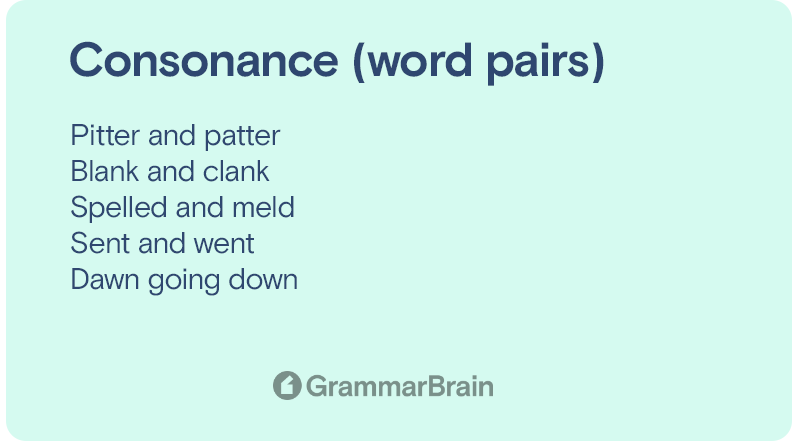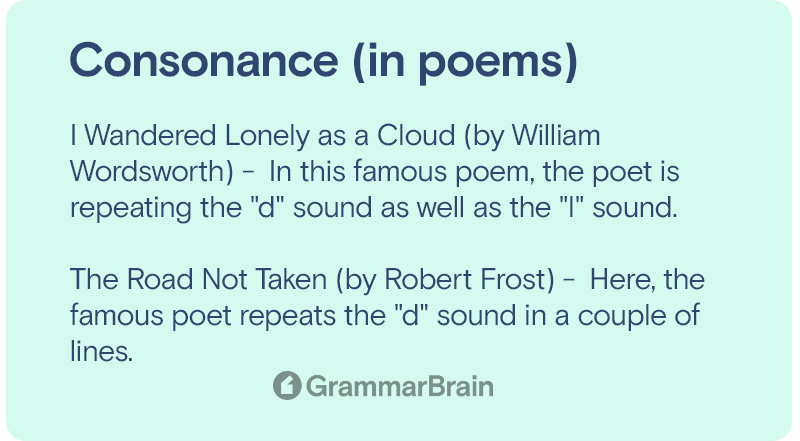What is consonance? The word ‘consonance‘ has multiple meanings in different domains, be it music or physics. However, in English grammar, it is a literary tool that involves repeating sounds of a similar consonant in a text.
Poets love tinkering with consonants as they use them as stylistic figures of speech to get their point across. Continue reading if you also want to learn more about it to develop your poetry skills!

What is consonance?
Consonance is a sound device that involves the repetition of same-sounding words within a group of words. For example – “The fair breeze blew, the white foam flew”.
It is important to note that literary consonance involves the repetition of sounds and not letters or words. In the above example, the sound “b” matters not the letter “b”.
Also, you do not have to put the exact sounding words side by side to produce consonance. As long as the words sound the same and are in proximity to each other, you can establish a consonant.
So, repeated sounds (consonance) can be present in any part of the sentence, be it the starting, the middle, or the end.
The term ‘consonance’ comes from the Latin word ‘consonantem’, which means ‘agreeing in sound.’ The same-sounding words can even be hidden at the end of stressed or unstressed syllables of a text.
Usually, the repetition happens in quick succession, as in “Taco Tuesdays” or “Muddy Maddy.”
Definition of consonance
Merriam-Webster defines consonance as the “recurrence of consonants at the end of stressed syllables without the similar correspondence of vowels”.
Per the Collins dictionary, consonance is “the repetition of a consonant sound stressed syllables in the middle or at the end of words.”

Examples of consonance in sentences
Here are a few sentence examples that’ll present a clearer picture (similar-sounding words are highlighted in bold):
- She rode a path wreathed in the growth of thorns.
- Let’s Take a sneak peek!
- Patrick Pope picked a peck of pickled poppers.
- Do you smell the stink of the sink?
- He dressed as a filthy, healthy wraith for Halloween.
- The girl’s mother gave her a red leather bag.
- The snail slithered slowly.
- The girl had a toffee, an elephant ear, and a waffle at the zoo.
- The blistering storm made the bell blow up
- Moments after Tom called for Pam she told them about Manny.
- Toss the ball, Ross.
- They will creep and beep while you sleep.
- The silver sack is on her back.
- She struck a streak of good luck in the street.
- Ben likes singing with his new mic.
Word pair consonance examples
Here are a few word pair consonance examples:
- Pitter and patter
- Blank and clank
- Spelled and meld
- Sent and went
- Dawn going down
- Laughed and halved
- Cheer and sneer
- Far and ajar
- Hard and bard
- Coughed and roughed
- Borrow and morrow
- Pain and rain
- Pain and gain
- Wine and dine
- Duck and tuck
- Better late than never
- Odds and ends
- Tea & toast
- A little later
- Front & center

Examples of consonance in poems
The use of consonance in poems is common as it creates rhythm and rhyme. Here are a few examples of popular poems that exhibit consonance:
- I Wandered Lonely as a Cloud (by William Wordsworth) – In this famous poem, the poet is repeating the “d” sound as well as the “l” sound.
- The Road Not Taken (by Robert Frost) – Here, the famous poet repeats the “d” sound in a couple of lines.
- Introduction to Poetry (by Billy Collins) – In this poem, the ‘l’ sound is repeated at the end of the third line.
- Amends (by Adrienne Rich) – In this poem, the author repeats the ‘l’ sound as well as the ‘k’ sound in the first line of the last stanza, adding multiple forms of consonance.
- The Bells (by Edgar Allen Poe) – In this poem, Edgar Allen Poe repeats both the ‘l’ and ‘t’ sounds in the same line.
- Shall I Wasting in Despair (by George Wither) – In this poem, multiple consonants such as the ‘d’, ‘f,’ and ‘r’ sounds repeat themselves:
List of examples
- The Tyger (by William Blake)
- Poem 315 (by Emily Dickinson)
- Out-Out (by Robert Frost)
- The Acrobats (by Shel Silverstein)
- Stopping by the Woods on a Snowy Evening (by Robert Frost)
- Not Waving but Drowning (by Stevie Smith)
- The Love Song of J. Alfred Prufrock (by T.S. Eliot)
Why do we use consonance?
Consonance can give added emphasis to the meaning of a sentence, like an intensifier. It also makes words more memorable.
Its effective application can impart a musical quality to the text and make the words pop out. This encourages the reader to spend more time reading the text.
Sometimes, consonance can have a unique resonance with the meaning of a sentence. This makes the sentence sound more exciting and engaging.
Terms related to consonance
Apart from consonance, there are other literary tools that writers use along with it. They are mentioned as follows:
- Assonance – It involves repeating the same vowel sounds in consecutive or words in proximity to each other. For example – “Clap your hands, and stamp your feet.”
- Sibilance – It involves the repetition of ‘s,’ ‘sh,’ and ‘z’ sounds in a given text. For example – “Sarah’s silly sister swallowed her sweet.”
- Alliteration – It involves repeating consonant or vowel sounds only at the beginning of words in a text. For example – “Sally sells seashells by the sea shore.”
- Rhyme – It involves repeating consonant or vowel sounds at the end of each word. For example – “See you later, alligator.”
FAQs
What is consonance in speech?
It is a figure of speech that refers to the repetition of consonant sounds in a text. The repetition can happen in the middle or at the end of words.
What is the most common consonant?
In the English language, the top three consonants in terms of popularity are ‘R’, ‘S’, and ‘T’.
What is consonance vs. assonance?
Even though both terms involve the repetition of sounds, consonance involves the repetition of consonant sounds, and assonance involves the repetition of vowel sounds.
What are the top 5 consonants in English?
In English, the top five most frequent consonants, along with the percentage of words they appear in, are – r (7.58%), t (6.95%), n (6.65%), s (5.73%), and l (5.48%).
How do you know if something is consonance?
It is important to note that when we call something consonance, we mean only the consonant sounds (such as ‘s’, ‘t’, ‘c’, etc.) repeat themselves – not vowel sounds.
What are 2 examples of alliteration?
Some common examples of alliteration are – French fry, cream of the crop, super size, tough talk, trick or treat, etc.
What are 2 examples of assonance?
Some common examples of assonance are – dips and chips, surf and turf, no pain, no gain, do good have good, etc.
What is a consonant rhyme?
These refer to certain words in which the consonants sound the same, but the vowel sounds are different
What is consonance vs. alliteration?
Alliteration refers to consonant sounds repeated in two or more words in a sentence that are consecutive or near each other. On the other hand, consonance occurs when consonant sounds get repeated in the middle or at the end of a word.
Why is consonance used in poems?
They are used in poems to add more depth to the words and enhance their texture. The use of consonance can also produce rhyme – enabling the poet to have more creative bandwidth.
Inside this article
Fact checked:
Content is rigorously reviewed by a team of qualified and experienced fact checkers. Fact checkers review articles for factual accuracy, relevance, and timeliness. Learn more.
Core lessons
Glossary
- Abstract Noun
- Accusative Case
- Anecdote
- Antonym
- Active Sentence
- Adverb
- Adjective
- Allegory
- Alliteration
- Adjective Clause
- Adjective Phrase
- Ampersand
- Anastrophe
- Adverbial Clause
- Appositive Phrase
- Clause
- Compound Adjective
- Complex Sentence
- Compound Words
- Compound Predicate
- Common Noun
- Comparative Adjective
- Comparative and Superlative
- Compound Noun
- Compound Subject
- Compound Sentence
- Copular Verb
- Collective Noun
- Colloquialism
- Conciseness
- Consonance
- Conditional
- Concrete Noun
- Conjunction
- Conjugation
- Conditional Sentence
- Comma Splice
- Correlative Conjunction
- Coordinating Conjunction
- Coordinate Adjective
- Cumulative Adjective
- Dative Case
- Determiner
- Declarative Sentence
- Declarative Statement
- Direct Object Pronoun
- Direct Object
- Diction
- Diphthong
- Dangling Modifier
- Demonstrative Pronoun
- Demonstrative Adjective
- Direct Characterization
- Definite Article
- Doublespeak
- False Dilemma Fallacy
- Future Perfect Progressive
- Future Simple
- Future Perfect Continuous
- Future Perfect
- First Conditional
- Irregular Adjective
- Irregular Verb
- Imperative Sentence
- Indefinite Article
- Intransitive Verb
- Introductory Phrase
- Indefinite Pronoun
- Indirect Characterization
- Interrogative Sentence
- Intensive Pronoun
- Inanimate Object
- Indefinite Tense
- Infinitive Phrase
- Interjection
- Intensifier
- Infinitive
- Indicative Mood
- Participle
- Parallelism
- Prepositional Phrase
- Past Simple Tense
- Past Continuous Tense
- Past Perfect Tense
- Past Progressive Tense
- Present Simple Tense
- Present Perfect Tense
- Personal Pronoun
- Personification
- Persuasive Writing
- Parallel Structure
- Phrasal Verb
- Predicate Adjective
- Predicate Nominative
- Phonetic Language
- Plural Noun
- Punctuation
- Punctuation Marks
- Preposition
- Preposition of Place
- Parts of Speech
- Possessive Adjective
- Possessive Determiner
- Possessive Case
- Possessive Noun
- Proper Adjective
- Proper Noun
- Present Participle
- Prefix
- Predicate



